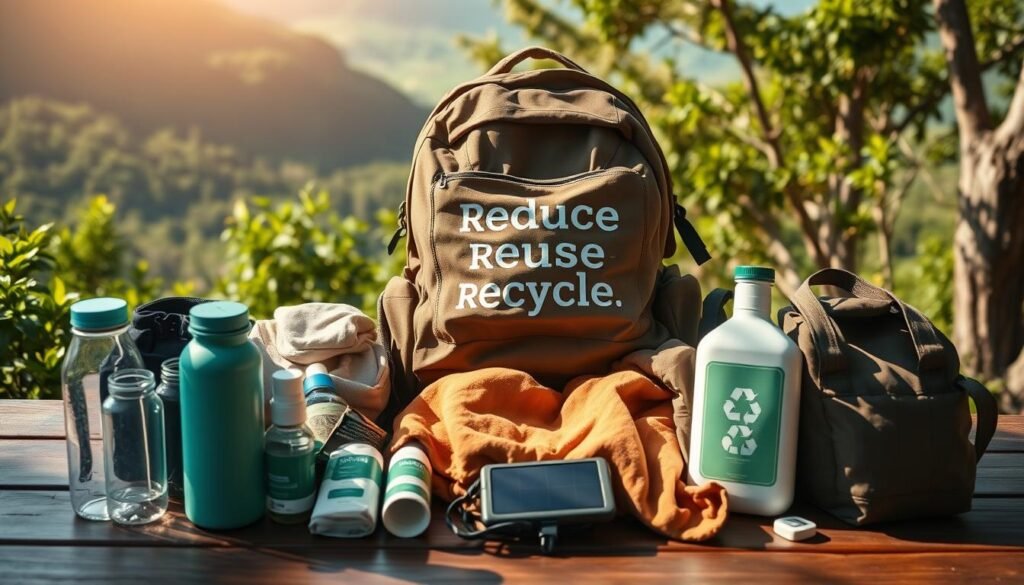Eco-Friendly Travel Tips :
When we travel, it’s key to think about how our actions affect the planet.
National Geographic Traveller (UK) says the tourism industry is a big source of greenhouse gas emissions. This makes sustainable travel very important.
By using eco-friendly practices, we can lessen our impact on the environment. This helps keep our planet beautiful for those who come after us.
Key Takeaways
- Understand the impact of travel on the environment
- Learn simple ways to make your travel more sustainable
- Discover eco-friendly destinations and activities
- Explore green tourism initiatives and their benefits
- Make informed choices to reduce your carbon footprint while traveling
Understand the Importance of Eco-Friendly Travel
Sustainable travel means making choices that are good for the environment and local communities. It’s about being aware of how our actions affect the places we visit. This way, we can enjoy exploring new places without harming them.
What is Sustainable Travel?
Sustainable travel, or eco-tourism, focuses on protecting nature and respecting local cultures. It includes many actions, like staying in environmentally friendly accommodations and reducing waste. By doing this, we help keep the places we visit beautiful for others to see.
Being aware of our carbon footprint is a big part of sustainable travel. We can choose to travel by train or bus instead of flying. We can also pick places to stay that use green energy.
Benefits of Eco-Friendly Travel
Eco-friendly travel has many good effects. It helps keep our planet clean and supports local businesses. By staying in locally owned accommodations and eating at family-run places, we help the communities we visit.
It also makes our travels more meaningful. By connecting with local cultures and caring for the environment, we build a stronger bond with the places we explore. This way of traveling encourages others to do the same, making a bigger difference together.
Choose Green Transportation Options
Traveling sustainably starts with picking transport that’s kind to the planet. As people become more aware of their carbon footprint, they’re looking for eco-friendly ways to travel.
Public Transportation: A Smart Choice
Public transport is a simple way to cut down on carbon emissions. Buses, trains, and subways are better for the environment and save money. Cities like Tokyo and London have great public transport systems, making it easy to travel without a car.
Benefits of Public Transportation:
- Reduced carbon emissions
- Cost-effective
- Culturally immersive experience
Carpooling and Ride-Sharing Platforms
Carpooling and ride-sharing are great for making travel greener. Services like UberPool and BlaBlaCar link people going the same way, cutting down on cars. This lowers emissions and lets you meet new people.
| Platform | Description | Environmental Impact |
|---|---|---|
| UberPool | Ride-sharing service that connects drivers with passengers heading in the same direction. | Reduces the number of cars on the road, lowering emissions. |
| BlaBlaCar | Carpooling platform that matches drivers with empty seats to travelers. | Decreases the carbon footprint by maximizing the use of available car seats. |
Electric Vehicle Options
Electric vehicles (EVs) are gaining popularity as a green choice. Many rental companies now offer EVs, making it easier to travel sustainably. EVs don’t produce tailpipe emissions, which helps reduce air pollution.
By picking green transport, travelers can help lower global carbon emissions. Whether it’s public transport, carpooling, or EVs, every choice helps promote sustainable tourism.
Select Eco-Conscious Accommodations
Choosing the right place to stay can really help the planet. More people now want to travel in a way that’s good for the environment. This has led to more hotels and rentals that are green.
Look for Green Certification
Looking for green certifications is a smart move. These are given to places that follow strict environmental rules. For example, LEED is a big name in green buildings.
Green certification covers many important areas:
- Using less energy with LED lights and appliances
- Conserving water with special showerheads and toilets
- Reducing waste and recycling
- Choosing materials that are good for the planet
Sustainable Hotels and Hostels
More hotels and hostels are going green. They use clean energy, save water, and buy local products. Some even aim to produce no waste at all.
When you book, look for places that show off their green efforts. They might talk about saving energy, using local products, and helping the community.
Eco-Friendly Vacation Rentals
Eco-friendly vacation rentals are a great choice too. Owners are adding features like solar panels and rainwater tanks. These rentals let you live like a local while being kind to the planet.
Platforms like Airbnb and VRBO make it easy to find these rentals. Just use keywords like “eco-friendly” or “green” to find the right spot.
By picking eco-friendly places to stay, we all help make travel better for the planet. Whether it’s a certified hotel or a green rental, every choice helps us move towards a greener future.
Pack Light and Smart
Embracing eco-conscious packing is a simple way to reduce waste while traveling. By using a few easy strategies, we can cut down our carbon footprint. This helps make tourism more sustainable.
Minimalist Packing for Eco-Friendly Travel
Minimalist packing is more than just carrying less. It’s about changing how we think about waste. Plan your outfits and pick items that can be worn many times. This saves space and reduces waste.
Choosing items with little or biodegradable packaging is also key. Use refillable containers for toiletries instead of plastic bottles. And pack clothes made from sustainable materials for even more eco-friendliness.

Eco-Friendly Travel Gear to Consider
Buying eco-friendly travel gear supports sustainable tourism. Look for items made from recycled or sustainable materials. Reusable water bottles, bamboo utensils, and bags from recycled plastics are great choices.
Some brands now offer gear made from recycled ocean plastic or designed sustainably. When buying, think about the product’s durability and if it can be recycled. This ensures it fits your eco-friendly travel goals.
Tips for Reducing Plastic Waste
Reducing plastic waste is key for eco-friendly travel. Carry a reusable water bottle and coffee cup. Avoid single-use plastics like straws and cutlery. Instead, use reusable alternatives or products with minimal packaging.
Also, be mindful of your shopping while traveling. Choose local items with little packaging and avoid plastic-wrapped goods. These small changes can greatly reduce plastic waste and help keep our environment clean.
Explore Local Cultures Responsibly
When you travel, it’s important to do so responsibly. This way, you make sure everyone has a good time. It also helps keep cultural heritage alive and supports local communities.
Support Local Businesses
Supporting local businesses is a great way to travel responsibly. Try eating at local restaurants, buying from family-owned shops, and hiring local guides. This helps the local economy and keeps traditional ways of life alive.
Benefits of Supporting Local Businesses:
- Contributes to the local economy
- Helps preserve cultural traditions
- Enhances your travel experience with authentic interactions
Respect Cultural Norms and Practices
Respecting local customs is key to responsible travel. Be aware of local traditions, dress right, and join in cultural events with care. This way, you avoid causing offense and connect deeply with the culture.
Tips for Respecting Cultural Norms:
- Research local customs before your trip
- Dress modestly and appropriately for cultural sites
- Participate in cultural activities with an open mind and respect
Participate in Responsible Wildlife Tourism
Responsible wildlife tourism is key for animal and habitat conservation. It makes travel better and helps animals.
Ethical wildlife sanctuaries are safe for animals rescued or needing care. They focus on rehab and conservation. Travelers can support these efforts by visiting.
Visit Ethical Wildlife Sanctuaries
Choosing a wildlife sanctuary wisely is important. Look for ones that care about animal welfare. Good signs include:
- No animal shows that harm them for fun.
- They work on rehab and release.
- They teach about conservation and wildlife.
Avoid Activities That Exploit Animals
Some tours harm animals for fun. Riding elephants or taking tiger selfies is wrong. It’s important to know this and stay away.
Choose tours that care about animals. Many offer safe ways to see wildlife. This helps animals and stops cruel practices.
Here’s how to avoid harm:
- Check tour operators for animal care.
- Don’t touch or feed wild animals.
- Support places that help animals recover and release.
Responsible tourism helps protect animals and their homes. It ensures a future for wildlife tourism.
Minimize Your Carbon Footprint
Sustainable travel begins with understanding and reducing our carbon footprint. As travelers, we can make a big difference. We can do this by adopting practices that lessen our environmental impact.
One effective way to cut down your carbon footprint is by offsetting your carbon emissions. This means calculating the carbon dioxide you emit while traveling. Then, you invest in projects that cut down greenhouse gas emissions elsewhere.
Tips for Offsetting Carbon Emissions
- Use a carbon offset calculator to figure out your emissions.
- Invest in renewable energy projects or reforestation programs.
- Support organizations that work on reducing global carbon emissions.
Offsetting carbon emissions is more than just making up for our emissions. It’s also about being mindful of our daily travel habits. Simple actions like choosing direct flights, traveling during off-peak seasons, and using eco-friendly transport can greatly reduce our carbon footprint.
Sustainable Travel Apps for Tracking
There are many sustainable travel apps to help track and lessen your environmental impact. These apps let you:
- Calculate your carbon footprint based on your travel activities.
- Find eco-friendly accommodations and transportation options.
- Offset your carbon emissions directly through the app.
Apps like TripIt and Carbon Travel offer tools and resources for more sustainable travel choices.
By using these strategies and the right tools, travelers can greatly reduce their carbon footprint. This helps make travel more sustainable for the future.
Engage in Eco-Friendly Activities
Doing eco-friendly activities is key to sustainable travel. It lets us see new places while keeping them beautiful. By picking activities that don’t harm the environment, we help save natural resources and support local people.

Nature Trails and Hiking
Going on nature trails and hiking is a great way to enjoy the outdoors. It lets us connect with nature, see beautiful views, and stay fit. Many national parks and protected areas have trails for all fitness levels.
Benefits of Nature Trails and Hiking:
- Promotes physical health and well-being
- Supports local economies through tourism
- Encourages conservation of natural habitats
Volunteer Opportunities During Travel
Volunteering while traveling is another way to help the environment. By joining conservation projects, community work, or wildlife protection, we can make a difference. Volunteer tasks can include planting trees or helping at animal shelters.
Tips for Volunteering:
- Research reputable organizations and projects
- Consider the local needs and cultural context
- Be prepared to learn and contribute effectively
By doing these eco-friendly activities, travelers can improve their trips and help the places they visit stay sustainable.
Practice Leave No Trace Principles
It’s key to follow Leave No Trace principles to keep our destinations beautiful. As more people explore the outdoors, it’s vital to reduce our environmental impact.
How to Follow Leave No Trace Guidelines
To follow Leave No Trace, start by planning ahead and preparing. Research the area, know local rules, and pack the right stuff. Traveling on durable surfaces means staying on trails and avoiding sensitive spots.
Also, dispose of waste properly. This means taking all trash and leftover food with you. And remember, leave what you find, don’t take plants, rocks, or other natural items.
“Leave nothing behind but bubbles, take nothing but memories.”
Benefits of Keeping Nature Untouched
Keeping nature untouched helps a lot. It preserves biodiversity and protects natural habitats. This way, future generations can enjoy the same beauty we do.
It also supports ecotourism and local economies that rely on tourism. It helps us connect more with nature, promoting care for the environment.
By following Leave No Trace, we help with environmental conservation and nature preservation. This keeps our planet vibrant and healthy for the future.
Be Aware of Your Water and Energy Use
Mindful travel is key to protecting our environment. Our daily choices can greatly affect the places we visit.
Knowing how much water and energy we use is important. It’s not just about reducing our impact. It’s also about showing respect for local resources and communities.
Reducing Water Consumption on the Go
There are easy ways to use less water while traveling. Taking shorter showers or turning off the tap while brushing teeth can help a lot.
- Choose accommodations that promote water-saving practices.
- Be mindful of your water usage in daily activities like bathing and washing clothes.
- Support hotels and resorts that have implemented water conservation measures.
| Water Conservation Tip | Impact |
|---|---|
| Take a 5-minute shower | Saves up to 20 gallons of water |
| Turn off tap while brushing teeth | Saves up to 4 gallons of water per day |
Conserving Energy in Your Accommodations
Conserving energy is just as important. There are many ways to do this in your accommodations. Start by choosing hotels or vacation rentals that use energy-efficient appliances and lighting.
Simple Energy-Saving Actions:
- Turn off lights, air conditioning, and heating when not in use.
- Use energy-efficient devices and adjust your usage habits.
- Support accommodations that use renewable energy sources.
By being mindful of our water and energy use, we make travel more sustainable. We also inspire others to do the same.
Connect with Like-Minded Travelers
Meeting travelers who love sustainable tourism is rewarding. It makes your trips better and helps the environment.
Joining Forces for a Greener Future
Joining eco-conscious groups is a great idea. You’ll meet people who care about the planet. These groups plan tours, share advice, and help protect nature.
Participating in Eco-Friendly Initiatives
Many travel programs focus on saving the environment. You can help by joining these efforts. This way, you help keep places beautiful for future visitors.
Being part of a group that values sustainability is powerful. Look for eco-conscious groups and programs. Together, we can make travel better for our planet.

















[…] June 23, 2025Sustainable Travel Made Easy: Eco-Friendly Travel TipsGet expert eco-friendly travel t… […]